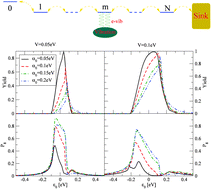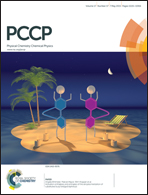The influence of polaron formation on exciton dissociation
Abstract
A linear tight-binding model was used to examine the yield of exciton dissociation under the influence of the electron–vibration interaction. The system consists of a linear chain, coupled to a single vibration, and electron–vibration interaction is permitted to occur on certain sites. In the presence of this interaction, population tends to localize to build a polaron. The system loses polaron trapping energy to the environment through its coupling to the bath environment, and loses population due to the injection into the electrode at the terminal site. A self-energy term was generated from population injection, and was added to the energy level of the last site, working as a sink function to absorb the electrons and measure the yield. This injection occurs only when the electron energy is inside and around the band. When the electron energy is outside the tight-binding band, population injection is inhibited. Our aim is to investigate the exciton dissociation effected by the competition between polaron formation and population injection, via a process strongly influenced by the inter-site coupling and the electron–vibration interaction.


 Please wait while we load your content...
Please wait while we load your content...